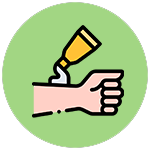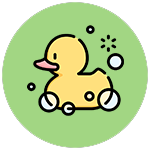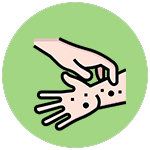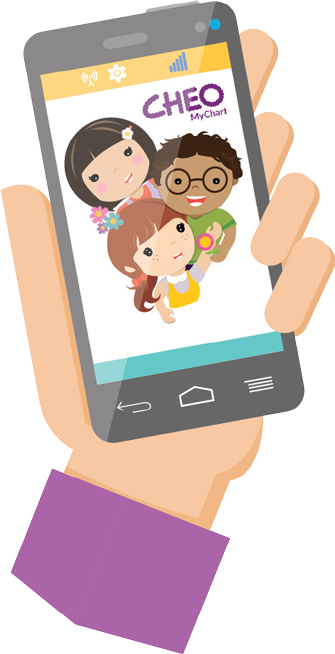
For best results make sure background graphics are enabled.
| Table of contents |
What is eczema?
The skin of children and youth with eczema:
- does not block out allergens (like dust mite droppings) as well as it should
- does not fight germs on the skin (bacteria like staph aureus) as well as it should• Is hypersensitive (too sensitive) to these germs and allergens
- does not fight certain skin viruses very well (like Herpes Simplex-the ‘cold sore’ virus)
This can cause:
- dry skin
- germs on the skin to grow
- flares of itching and rash
- severe skin infections
- scratch-itch-scratch cycles - part of the scratching is a habit
How is eczema treated?
Eczema can be treated with prescription skin ointments, oral medications or both
Creams and ointments
These usually contain small amounts of cortisone, which calms the skin’s reaction to allergens. Your doctor may prescribe stronger creams for short periods of time if needed. Remember to:
- Use a tongue depressor to take ointment or cream out of the jar (this keeps germs out).
- Apply a thin layer and rub into to the problem areas twice a day.
Antihistamines
Your doctor may prescribe these oral medications (taken by mouth). They can help your child or teen rest when scratching leads to poor sleep.
Antibiotics
Antibiotics may be needed sometimes to treat skin infections.
Keeping eczema under control
There are many ways to help your child or teen keep eczema under control.
Bathing
It will help for children and youth to:
- Take lukewarm baths or showers, 3-7 times each week
- • Use a mild skin cleanser (like Dove® unscented soap)
- • Pat skin dry with a towel, leaving skin a little damp
Clothing
Some clothing can irritate the skin. To prevent this, make sure your child or teen:
- Wears cotton clothing as much as possible
- Avoids wool, or rough fabric
- Wears loose, light clothing in summer
- Has two pairs of winter boots (one pair is kept dry)
- Wears leather shoes
- Wears rubber gloves (over cotton gloves, if possible) for wet work
Moisturizing
Apply a moisturizing cream to damp skin after a bath or shower. This ‘traps’ water in the skin, and helps skin keep germs and allergens out. Avoid creams or lotions with perfume, urea and alpha hydroxyl acids. Some helpful products:
- Aveeno®
- Glaxal Base®
- Cliniderm®Vaseline Creamy®
- Cetaphil cream®
- Petroleum jelly
Dust mites
Dust mite droppings are allergens that can make eczema worse. To control dust mites and their droppings:
-
vacuum the bedroom carpet everyday (or replace with a smooth floor if possible)
-
use special mattress and pillow covers (Vital Aire® )and under cotton liners or mattress covers
-
change furnace filters every 3-4 months
-
wash sheets and mattress covers once a week
Sunscreen
Some children with eczema are sensitive to regular sunscreens. If this happens, try:
- Neutrogena® SPF 30 for sensitive skin
- Aveno® SPF 25-50
Swimming
Make sure your child has a shower or bath right after swimming. Pat skin dry with a towel and apply a moisturizer when skin is still damp.
Habit reversal
This can be helpful with older children. First, we help children become more aware of their scratching. Children then learn less damaging ways to handle itching (like moisturizing or pinching).
Children and youth with more severe eczema
Your doctor will tell you if you should try these treatments:
- Infection control baths
- Give your child a bath with 1/4 to 1/2 cup bleach added to a half bathtub of water twice each week. Let your child sit in the bath for 5-10 minutes.
- Overnight wet wrap
- These wraps are applied after moisturizers and medicated creams and stay on overnight.
Questions?
For appointments and scheduling call:
Clinic clerk
613-737-7600 extension 2395
For questions about eczema call:
Clinic nurse: 613-737-7600 extension 1237
Have you registered for MyChart?
MyChart is a FREE secure, online patient portal that connects patients to parts of their CHEO electronic health record, anywhere, at any time.
To apply for MyChart access, visit cheo.on.ca/mychart and fill out the MyChart access request form. Once your application has been approved, we'll send you an email with an activation code and instructions on how to log in and get started.





